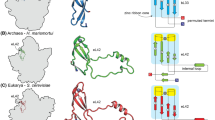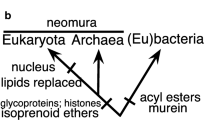Summary
The gene (fus) coding for elongation factor G (EF-G) of the extremely thermophilic eubacteriumThermotoga maritima was identified and sequenced. The EF-G coding sequence (2046 bp) was found to lie in an operon-like structure between the ribosomal protein S7 gene (rpsG) and the elongation factor Tu (EF-Tu) gene (tuf). TherpsG, fus, andtuf genes follow each other immediately in that order, which corresponds to the order of the homologous genes in thestr operon ofEscherichia coli. The derived amino acid sequence of the EF-G protein (682 residues) was aligned with the homologous sequences of other eubacteria, eukaryotes (hamster), and archaebacteria (Methanococcus vannielii). Unrooted phylogenetic dendrogram, obtained both from the amino acid and the nucleotide sequence alignments, using a variety of methods, lend further support to the notion that the (present) root of the (eu)bacterial tree lies betweenThermotoga and the other bacterial lineages.
Similar content being viewed by others
References
Auer J, Lechner K, Böck A (1989) Gene organization and structure of two transcriptional units fromMethanococcus coding for ribosomal proteins and elongation factors. Can J Microbiol 35:200–204
Bachleitner M, Ludwig W, Stetter KO, Schleifer KH (1989) Nucleotide sequence of the gene coding for the elongation factor Tu of the extremely thermophilic eubacteriumThermotoga maritima. FEMS Microbiol Lett 57:115–120
Blin N, Stafford DW (1976) Isolation of high molecular weight DNA. Nucleic Acids Res 3:2303–2308
Bolivar F, Rodriguez EL, Green P, Bettlach MC, Heynecker HL, Boyer HW, Crose J, Falkow S (1977) Construction and characterization of new cloning vehicles. II. A multipurpose cloning system. Gene 2:295–313
Buttarelli FR, Calogero RA, Tiboni O, Gualerzi CO, Pon CL (1989) Characterization of thestr operon genes fromSpirulina platensis and their evolutionary relationships to those of other prokaryotes. Mol Gen Genet 217:97–104
Dagert M, Ehrlich SD (1979) Prolonged incubation in calcium chloride improves the competence ofEscherichia coli cells. Gene 6:23–28
Dayhoff MO (1978) A model of evolutionary change in protein. Matrices for detecting distant relationships. In: Dayhoff MO (ed) Atlas of protein sequence and structure, vol 5, suppl 3. National Biomedical Research Foundation, Washington DC, pp 345–358
Dever TE, Glynias MJ, Merrick WC (1987) GTP-binding domain: three consensus sequence elements with distinct spacing. Proc Natl Acad Sci USA 84:1814–1818
Devereux I, Haeberli P, Smithies O (1984) A comprehensive set of sequence analyses programs for the VAX. Nucleic Acids Res 12:387–395
Felsenstein J (1981) Evolutionary trees from DNA sequences: a maximum likelihood approach. J Mol Evol 17:368–376
Felsenstein J (1984) The statistical approach to inferring evolutionary trees and what it tells us about parsimony and compatibility. In: Ducan T, Stuessy TF (eds) Cladistics: perspectives in the reconstruction of evolutionary history. Columbia University Press, New York, pp 169–191
Felsenstein J (1985) Confidence limits on phylogenies: an approach using the bootstrap. Evolution 39:783–791
Feng DF, Johnson MS, Doolittle RF (1985) Aligning amino acid sequences: comparison of commonly used methods. J Mol Evol 21:112–125
Fitch WM, Margoliash E (1967) Construction of phylogenetic trees. Science 15:279–284
Higuchi R, Stang HD, Browne JK, Martin MO, Huot M, Lipeles J, Salser W (1981) Human ribosomal RNA gene spacer sequences are found interspersed elsewhere in the genome. Gene 15:177–186
Holmquist R, Miyamoto MM, Goodman M (1988) Analysis of higher primate phylogeny for transversion differences in nuclear and mitochondrial DNA by Lake's method of evolutionary parsimony and operator metrics. Mol Biol Evol 5: 217–236
Huber R, Langworthy TA, König H, Thomm M, Woese CR, Sleytr UB, Stetter KO (1986)Thermotoga maritima sp. nov. represents a new genus of unique extremely thermophilic eubacteria growing up to 87°C. Arch Microbiol 144:324–333
Iwabe N, Kuma KI, Hasegawa M, Osawa S, Miyata T (1989) Evolutionary relationship of archaebacteria, eubacteria and eukaryotes inferred from phylogenetic trees of duplicated genes. Proc Natl Acad Sci USA 86:9355–9359
Jaskunas SR, Lindhal R, Nomura M, Burgess RR (1975) Identification of two copies of the gene for elongation factor EF-Tu inEscherichia coli. Nature 257:458–462.
Jaskunas SR, Fallon AM, Nomura M (1977) Identification and organization of ribosomal protein genes ofEscherichia coli carried by thefus2 transducing phage. J Biol Chem 252:7323–7336
Khono K, Uchida T, Ohkubo H, Nakanishi S, Nakanishi T, Fukui T, Ohtuka E, Ikehara M, Okada Y (1986) Amino acid sequence of mammalian elongation factor 2 deduced from the cDNA sequence: homology with GTP-binding proteins. Proc Natl Acad Sci USA 83:4978–4982
Lake JA (1987a) A rate-independent technique for analysis of nucleic acid sequences: evolutionary parsimony. Mol Biol Evol 4:167–191
Lake JA (1987b) Determining evolutionary distances from highly diverged nucleic acid sequences: operator metrics. J Mol Evol 26:59–73
Lake JA (1988) Origin of the eukaryotic nucleus determined by rate-invariant analysis of rRNA sequences. Nature 331: 184–186
Lechner K, Böck A (1987) Cloning and nucleotide sequence of the gene for an archaebacterial protein synthesis elongation factor Tu. Mol Gen Genet 208:523–528
Lechner K, Heller G, Böck A (1988) Gene for the diphtheria toxin-susceptible elongation factor 2 fromMethanococcus vannielii. Nucleic Acids Res 16:7817–7826
Londei P, Altamura S, Huber R, Stetter KO, Cammarano P (1988) Ribosomes of the extremely thermophilic eubacteriumThermotoga maritima are uniquely insensitive to the miscoding inducing action of aminoglycoside antibiotics. J Bacteriol 170:4353–4360
Maniatis T, Fritsch EF, Sambrook J (1982) Molecular cloning: a laboratory manual. Cold Spring Harbor Laboratory Press, Cold Spring Harbor NY
Ohama T, Yamao A, Muto A, Osawa S (1987) Organization and codon usage of the streptomycin operon inMicrococcus luteus; a bacterium with a high genomic G+C content. J Bacteriol 169:4770–4777
Post LE, Nornura M (1980) DNA sequences from thestr operon ofEscherichia coli. J Biol Chem 255:4660–4666
Pühler G, Leffers H, Gropp F, Palm P, Klenk HP, Lottspeich F, Garrett R, Zillig W (1989) Archaebacterial DNA-dependent RNA polymerases testify to the evolution of the eukaryotic nuclear genome. Proc Natl Acad Sci USA 86:4569–4573
Sanger F, Nicklen S, Coulson AR (1977) DNA sequencing with chain terminating inhibitors. Proc Natl Acad Sci USA 74: 5463–5467
Southern E (1975) Detection of specific sequences among DNA fragments separated by gel electrophoresis. J Mol Biol 98: 503–517
Tiboni O, Sanangelantoni AM, Cammarano P, Cimino L, Di Pasquale G, Sora S (1989) Expression inEscherichia coli of thetuf gene from the extremely thermophilic eubacteriumThermotoga maritima: purification of theThermotoga elongation factor Tu by thermal denaturation of the mesophile host-cell proteins. Syst Appl Microbiol 12:127–133
Vieira J, Messing J (1982) The pUC plasmids and M13mp7-derived system for insertion, mutagenesis and sequencing with synthetic universal primers. Gene 19:259–268
Woese CR (1987) Bacterial evolution. Microbiol Rev 51:221–271
Zengel YM, Archer RH, Lindahl L (1984) The nucleotide sequence of theEscherichia coli fus gene coding for elongation factor G. Nucleic Acids Res 12:2181–2192
Zillig W, Palm P, Klenk HP, Pühler G, Gropp F, Schleper C (in press) Phylogeny of DNA-dependent RNA polymerases: testimony for the origin of eukaryotes. In: Rodriguez-Valera F (ed) General and applied aspects of halophilic microorganisms. Plenum, New York
Author information
Authors and Affiliations
Rights and permissions
About this article
Cite this article
Tiboni, O., Cantoni, R., Creti, R. et al. Phylogenetic depth ofThermotoga maritima inferred from analysis of thefus gene: Amino acid sequence of elongation factor G and organization of theThermotoga str operon. J Mol Evol 33, 142–151 (1991). https://doi.org/10.1007/BF02193628
Received:
Revised:
Issue Date:
DOI: https://doi.org/10.1007/BF02193628




